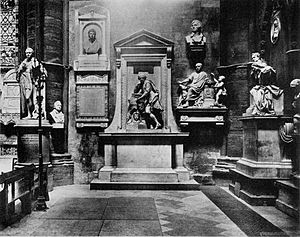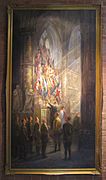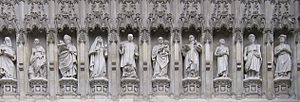Burials and memorials in Westminster Abbey facts for kids
Honoring people with burials and memorials in Westminster Abbey has been a tradition for a very long time. This famous church in London is a special place. Many important people from British history are buried or remembered here. These include kings, queens, poets, scientists, and leaders.
Contents
History
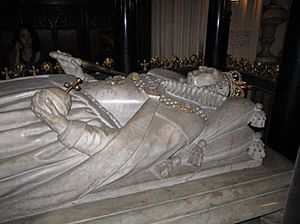
King Henry III rebuilt Westminster Abbey. He did this to honor Edward the Confessor, a royal saint. Edward's remains are now in a special vault near the main altar. Henry III himself was buried close by in a beautiful tomb. Many early English kings and queens, from the Plantagenet family, were also buried here.
Most Kings and Queens of England were buried in the Abbey from Edward the Confessor's time until George II died in 1760. Some exceptions include Henry VIII and Charles I. After George II, most monarchs were buried at Windsor Castle.
Since the Middle Ages, important families were buried inside the Abbey's chapels. Monks and other Abbey workers were buried in the Cloisters. One famous person buried here was Geoffrey Chaucer. He was a poet who worked at the Abbey. Other poets, writers, and musicians were buried or honored near Chaucer. This area became known as Poets' Corner. Famous names there include Charles Dickens, Rudyard Kipling, and Alfred, Lord Tennyson. Musicians like Henry Purcell were also buried where they worked.
Over time, being buried or remembered in Westminster Abbey became a great honor in Britain. This practice started with Oliver Cromwell and Admiral Robert Blake in the 1650s. Soon, generals, politicians, doctors, and scientists were also buried here. These include famous scientists like Isaac Newton and Charles Darwin.
Eight British Prime Ministers are buried in the Abbey. These include William Pitt the Elder and William Ewart Gladstone.
In the early 1900s, there was less space for burials. So, it became common to bury cremated remains (ashes) instead of coffins. The actor Sir Henry Irving was the first person to be cremated before being buried in the Abbey in 1905. More recently, the ashes of physicist Stephen Hawking were buried in the Abbey in 2018. His memorial stone is near Sir Isaac Newton's grave. It has a special message about black holes.
Just inside the main west door, in the middle of the Abbey, is the tomb of The Unknown Warrior. This is an unidentified British soldier from the First World War. He was buried there in 1920. You are not allowed to walk on this special grave.
Burials
British Monarchs and Consorts
Many English, Scottish, and British kings and queens are buried in the Abbey. Their spouses (consorts) are also buried there.
- Edward the Confessor and Edith of Wessex
- Henry III of England
- Edward I of England and Eleanor of Castile
- Edward III of England and Philippa of Hainault
- Richard II of England and Anne of Bohemia
- Henry V of England and Catherine of Valois
- Possibly Edward V of England and his brother, Richard, Duke of York. These are the "Princes in the Tower." Their remains were moved here in 1674.
- Henry VII of England and Elizabeth of York
- Edward VI of England
- Mary I of England
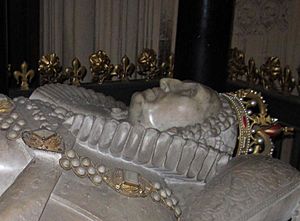
- Mary, Queen of Scots (moved here in 1612)
- Elizabeth I of England
- In the 1800s, researchers found Elizabeth I's coffin on top of her half-sister Mary I's coffin.
- James I of England and his wife, Anne of Denmark
- James I's tomb location was lost for 250 years. It was found in the 1800s.
- Charles II of England and Scotland
- Mary II of England and Scotland
- William III of England and II of Scotland
- Anne, Queen of Great Britain and her husband, Prince George of Denmark
- George II of Great Britain and his wife, Caroline of Ansbach
Other Royals
Many other royal family members are also buried in the Abbey. These include children and relatives of kings and queens.
- Prince Edmund "Crouchback", son of Henry III
- Prince Henry, son of Edward I
- Prince John, son of Edward II
- Prince Henry, son of Henry VIII
- Lady Arabella Stuart, a relative of Henry VII
- Elizabeth, Queen of Bohemia, daughter of James I
- Rupert, Prince Palatine, son of Elizabeth of Bohemia
- Henry Frederick, Prince of Wales, son of James I
- Mary, Princess Royal, daughter of Charles I
- Prince William, Duke of Gloucester, son of Queen Anne
- Frederick Louis, Prince of Wales (son of George II) and Princess Augusta of Saxe-Gotha
- Prince William Augustus, Duke of Cumberland, son of George II
- Princess Amelia of Great Britain, daughter of George II
- Prince Edward Augustus, brother of George III
Many famous people are buried in the main part of the Abbey, called the nave.
- Clement Attlee (Prime Minister)
- Bonar Law (Prime Minister)
- Neville Chamberlain (Prime Minister)
- Charles Darwin (scientist)
- Stephen Hawking (scientist)
- Ben Jonson (writer, buried standing up!)
- David Livingstone (explorer)
- Sir Isaac Newton (scientist)
- Ernest Rutherford (scientist)
- The Unknown Warrior (soldier)
North Transept
The North Transept holds the graves of several important political figures.
- George Canning (Prime Minister)
- William Pitt, 1st Earl of Chatham (Prime Minister)
- William Ewart Gladstone (Prime Minister)
- William Pitt the Younger (Prime Minister)
- William Wilberforce (abolitionist)
South Transept
The South Transept is famously known as Poets' Corner. Many writers and artists are buried here.
- Robert Browning (poet)
- Geoffrey Chaucer (poet)
- Charles Dickens (writer)
- John Dryden (poet)
- George Frederick Handel (composer)
- Thomas Hardy (writer)
- Sir Henry Irving (actor)
- Dr Samuel Johnson (writer)
- Rudyard Kipling (writer)
- John Milton (poet)
- Laurence Olivier (actor)
- Alfred Tennyson (poet)
Cloisters
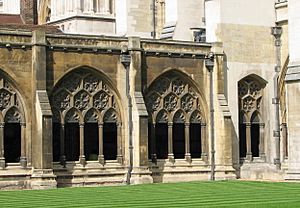
The cloisters are covered walkways around a courtyard. Some people connected to the Abbey are buried here.
- Aphra Behn (writer)
- Muzio Clementi (composer)
North Choir Aisle
- John Blow (composer)
- Henry Purcell (composer)
- Ralph Vaughan Williams (composer)
South Choir Aisle
- Sir Cloudesley Shovell (Admiral)
- Dame Sybil Thorndike (actress)
Ambulatory Chapels
These are smaller chapels around the main altar area.
St. Nicholas' Chapel
This chapel contains the "Northumberland Vault," a family burial place for the Percy family.
- Elizabeth Percy (d.1776)
- Hugh Percy, 1st Duke of Northumberland (d. 1786)
- Hugh Percy, 3rd Duke of Northumberland (d. 1847)
- Elizabeth Diana Percy (d. 2012) Ashes interred
St Paul's Chapel
- Sir Lewis Robessart (d. 1430)
- Catherine of Valois (Queen, d. 1437)
Other Ambulatory Chapels
- Anne of Cleves (wife of King Henry VIII)
- John of Eltham, Earl of Cornwall (son of Edward II)
- William de Valence, 1st Earl of Pembroke (half-brother of Henry III)
- George Villiers, 1st Duke of Buckingham (advisor to James I and Charles I)
Memorials
Some people are honored in Westminster Abbey with a memorial, but they are buried somewhere else.
Individuals
- Individuals memorialized in Westminster Abbey
-
"Placing the Canadian Colours on Gen. James Wolfe's Monument in Westminster Abbey" by Emily Warren
-
Old plaque for Robert Baden-Powell, now replaced with a new one also celebrating his wife, Olave
- Jane Austen (writer), buried in Winchester Cathedral.
- Robert, Lord Baden-Powell (founder of Scouting), buried in Kenya.
- Sir Winston Churchill (Prime Minister), buried in Oxfordshire.
- Lord Byron (poet), buried in Nottinghamshire.
- Diana, Princess of Wales, buried at Althorp.
- Sir Francis Drake (explorer), buried at sea.
- Martin Luther King Jr. (civil rights leader), honored with a statue.
- William Shakespeare (playwright), buried in Stratford-upon-Avon.
- Oscar Wilde (writer), honored with a stained glass window.
World War I Poets
Sixteen poets from the First World War are remembered on a special stone in Poets' Corner. They wrote about their experiences during the war.
20th-Century Martyrs
Above the Great West Door, there are statues of ten Christian martyrs from the 20th century. These are people who died for their faith.
- Maximilian Kolbe (Poland)
- Martin Luther King Jr. (USA)
- Óscar Romero (El Salvador)
- Dietrich Bonhoeffer (Germany)
Formerly Buried (Removed)
Sometimes, bodies were buried in the Abbey but later moved.
- King Harold I was first buried in the Abbey. But his body was later removed and thrown into a fen (a type of wetland). It was then re-buried in another church.
- Several people who supported Oliver Cromwell were buried in the Abbey. But in 1661, after King Charles II returned to power, their bodies were removed. They were re-buried in a pit outside the Abbey. This included Oliver Cromwell himself.
Proposed Burials and Memorials
Sometimes, there are discussions about who should be honored in the Abbey.
- King Richard III burial: After his remains were found in 2012, there was a debate about burying him in Westminster Abbey. However, he was eventually buried in Leicester Cathedral.
- Captain Sir Tom Moore memorial: After Captain Tom died in 2021, some people suggested he should have a memorial stone in the Abbey. This was to recognize his amazing fundraising efforts during the COVID-19 pandemic.
Images for kids
-
The monument for Gen. James Wolfe.
See also
 In Spanish: Enterramientos y memoriales en la abadía de Westminster para niños
In Spanish: Enterramientos y memoriales en la abadía de Westminster para niños


